MGT510 Strategic Management: Evaluating Amazon.com's Implementation
VerifiedAdded on 2023/06/04
|17
|4015
|179
Report
AI Summary
This report provides an evaluation of Amazon.com's strategic implementation plan, assessing its suitability within the current market trends. It begins with an introduction and background of Amazon.com, highlighting past strategic implementation efforts. The report then delves into the challenges faced by the organization in a competitive market, examining potential threats to its brand image and market leadership. Key issues are identified and followed by strategic recommendations aimed at addressing the identified gaps. The analysis covers aspects such as cost leadership, product diversification, and technological innovation. Finally, the report concludes with an authentic summary based on the comprehensive analysis conducted, offering insights into Amazon's strategic approach and potential areas for improvement. This document is available on Desklib, a platform offering study tools for students.
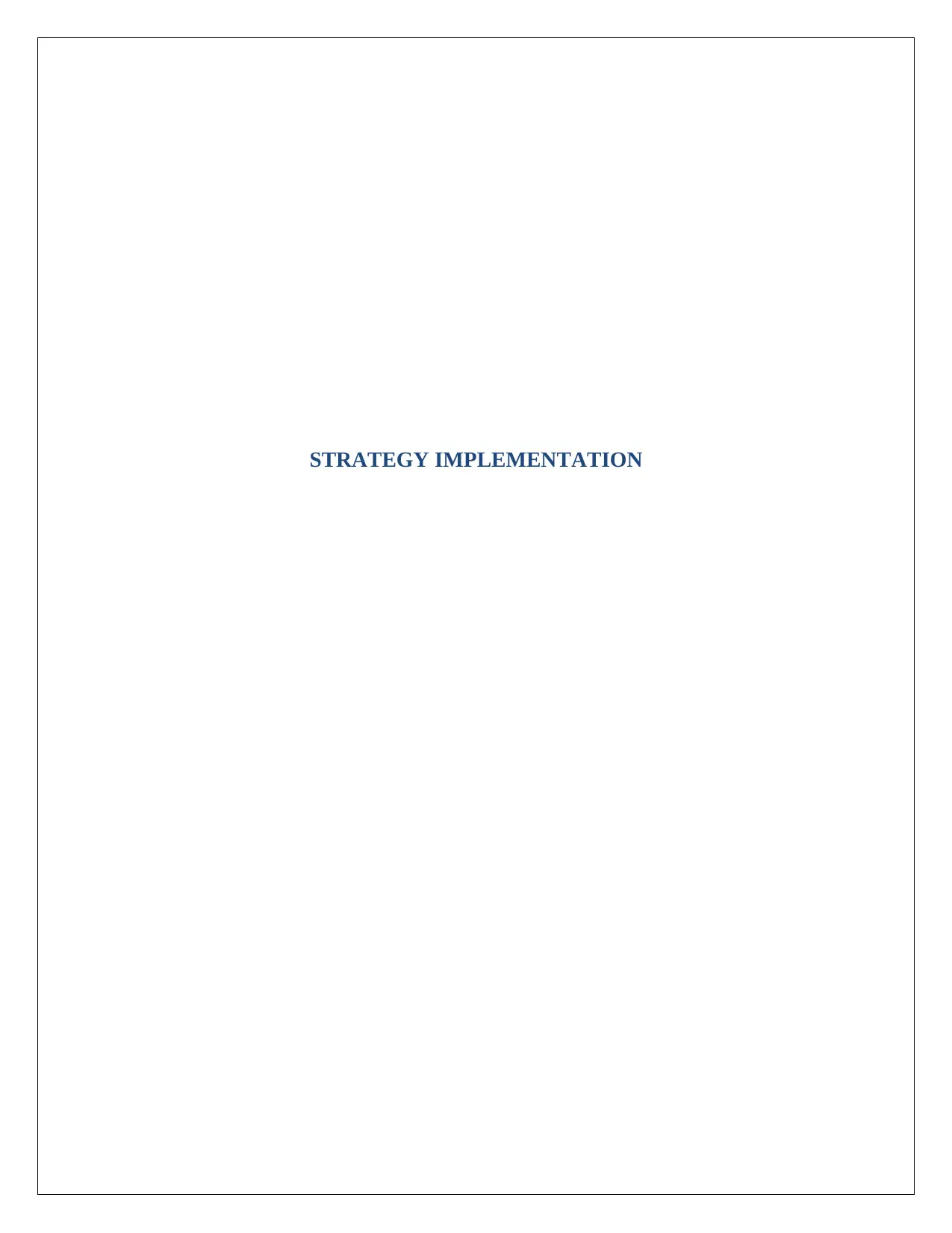
STRATEGY IMPLEMENTATION
Paraphrase This Document
Need a fresh take? Get an instant paraphrase of this document with our AI Paraphraser
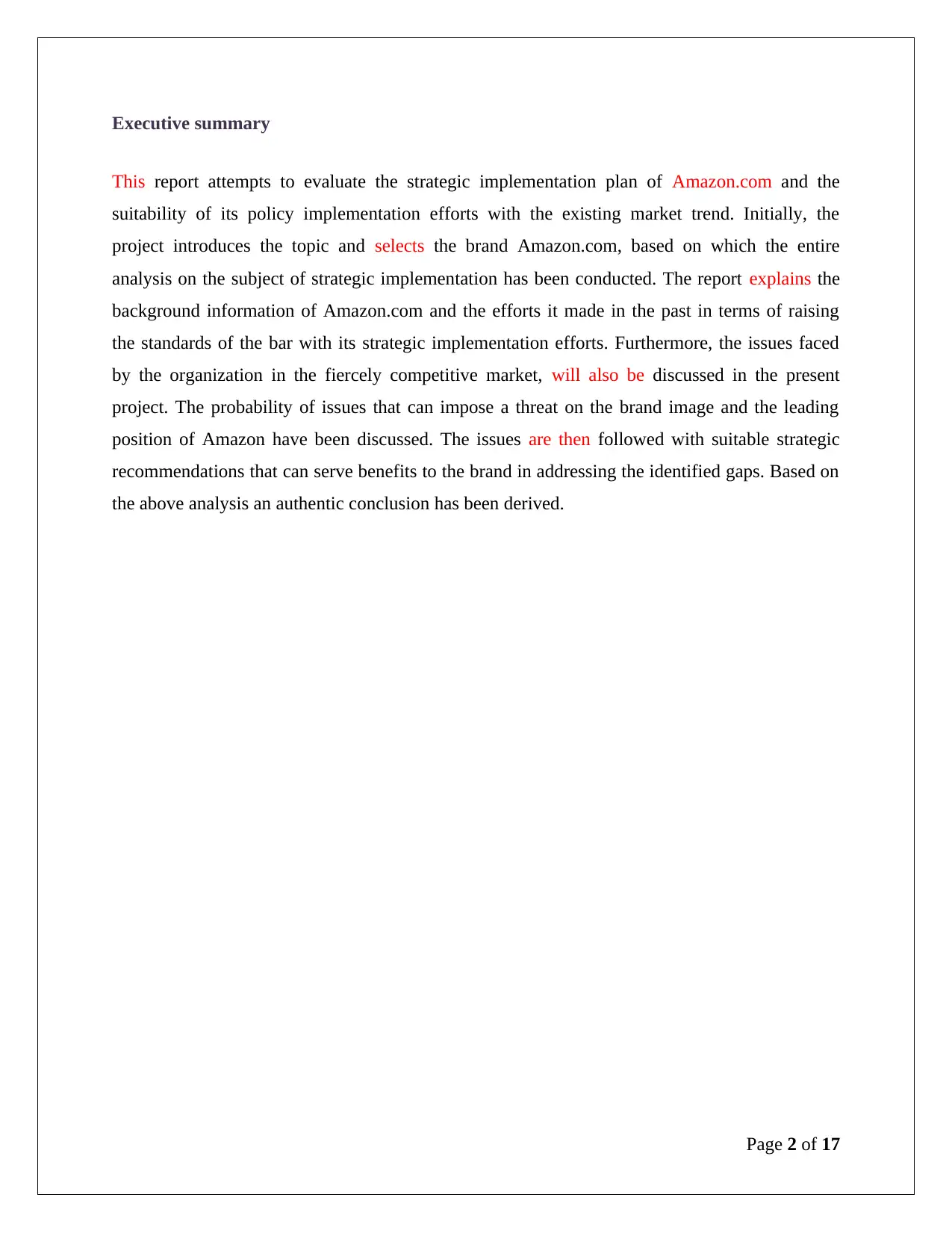
Executive summary
This report attempts to evaluate the strategic implementation plan of Amazon.com and the
suitability of its policy implementation efforts with the existing market trend. Initially, the
project introduces the topic and selects the brand Amazon.com, based on which the entire
analysis on the subject of strategic implementation has been conducted. The report explains the
background information of Amazon.com and the efforts it made in the past in terms of raising
the standards of the bar with its strategic implementation efforts. Furthermore, the issues faced
by the organization in the fiercely competitive market, will also be discussed in the present
project. The probability of issues that can impose a threat on the brand image and the leading
position of Amazon have been discussed. The issues are then followed with suitable strategic
recommendations that can serve benefits to the brand in addressing the identified gaps. Based on
the above analysis an authentic conclusion has been derived.
Page 2 of 17
This report attempts to evaluate the strategic implementation plan of Amazon.com and the
suitability of its policy implementation efforts with the existing market trend. Initially, the
project introduces the topic and selects the brand Amazon.com, based on which the entire
analysis on the subject of strategic implementation has been conducted. The report explains the
background information of Amazon.com and the efforts it made in the past in terms of raising
the standards of the bar with its strategic implementation efforts. Furthermore, the issues faced
by the organization in the fiercely competitive market, will also be discussed in the present
project. The probability of issues that can impose a threat on the brand image and the leading
position of Amazon have been discussed. The issues are then followed with suitable strategic
recommendations that can serve benefits to the brand in addressing the identified gaps. Based on
the above analysis an authentic conclusion has been derived.
Page 2 of 17
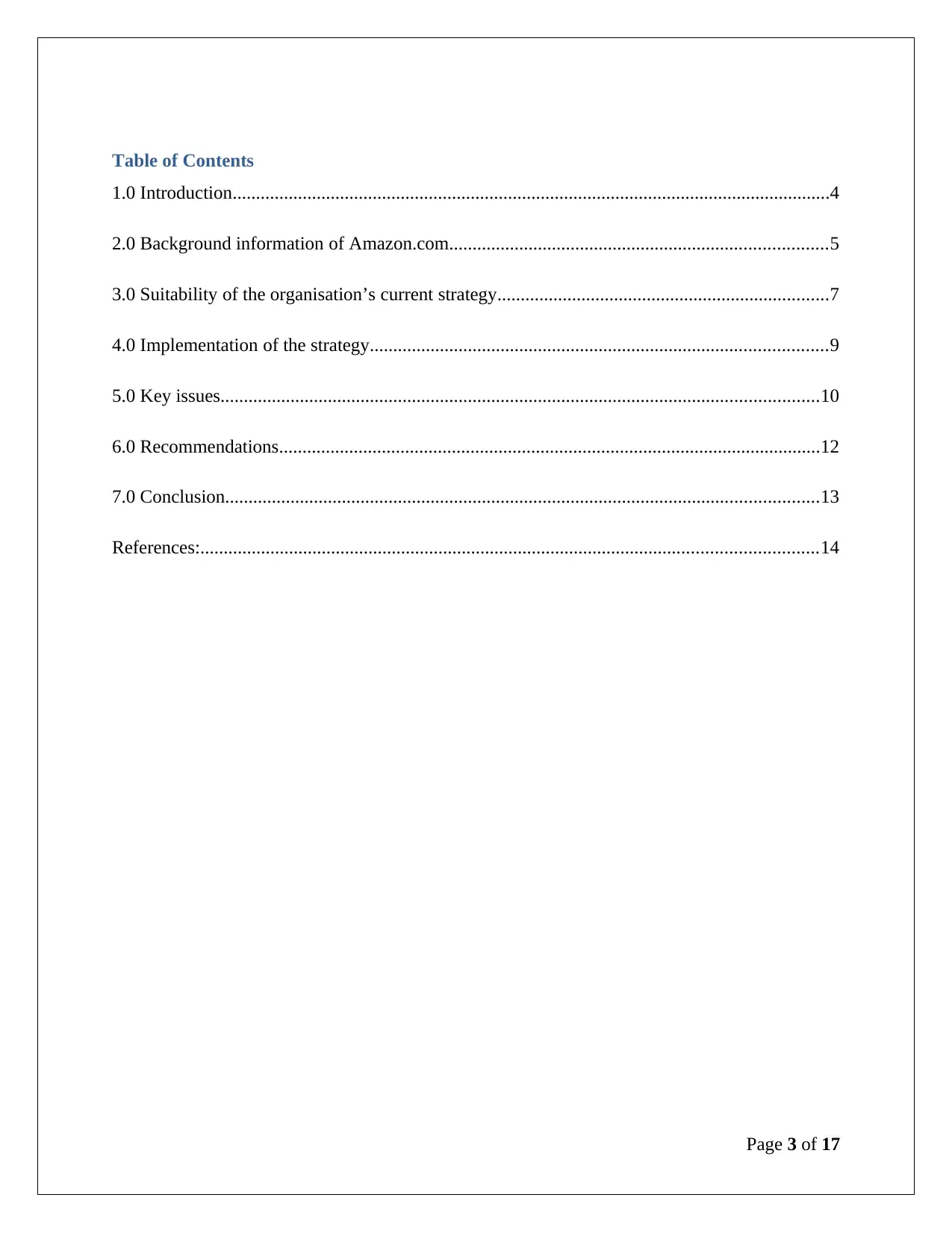
Table of Contents
1.0 Introduction................................................................................................................................4
2.0 Background information of Amazon.com.................................................................................5
3.0 Suitability of the organisation’s current strategy.......................................................................7
4.0 Implementation of the strategy..................................................................................................9
5.0 Key issues................................................................................................................................10
6.0 Recommendations....................................................................................................................12
7.0 Conclusion...............................................................................................................................13
References:....................................................................................................................................14
Page 3 of 17
1.0 Introduction................................................................................................................................4
2.0 Background information of Amazon.com.................................................................................5
3.0 Suitability of the organisation’s current strategy.......................................................................7
4.0 Implementation of the strategy..................................................................................................9
5.0 Key issues................................................................................................................................10
6.0 Recommendations....................................................................................................................12
7.0 Conclusion...............................................................................................................................13
References:....................................................................................................................................14
Page 3 of 17
⊘ This is a preview!⊘
Do you want full access?
Subscribe today to unlock all pages.

Trusted by 1+ million students worldwide
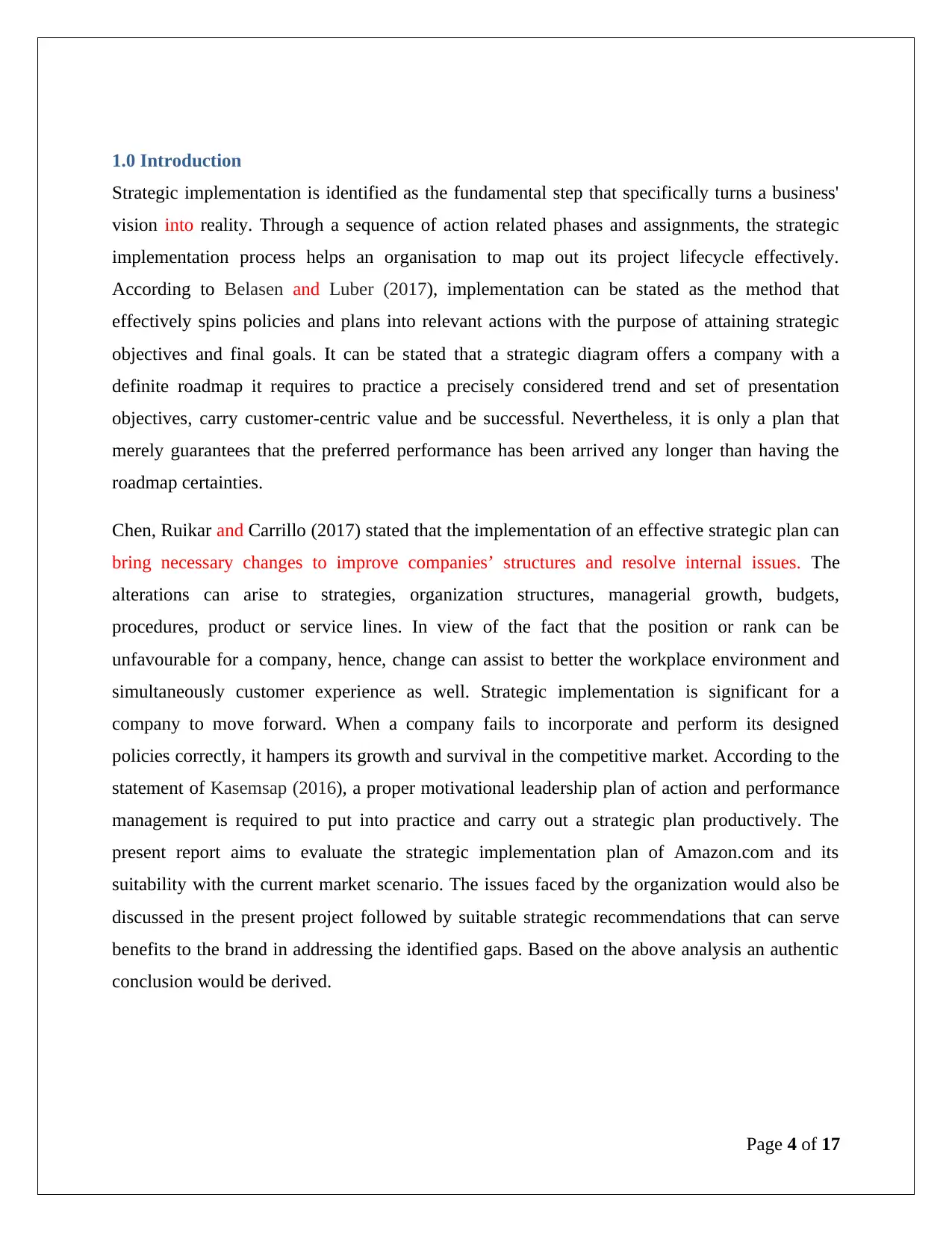
1.0 Introduction
Strategic implementation is identified as the fundamental step that specifically turns a business'
vision into reality. Through a sequence of action related phases and assignments, the strategic
implementation process helps an organisation to map out its project lifecycle effectively.
According to Belasen and Luber (2017), implementation can be stated as the method that
effectively spins policies and plans into relevant actions with the purpose of attaining strategic
objectives and final goals. It can be stated that a strategic diagram offers a company with a
definite roadmap it requires to practice a precisely considered trend and set of presentation
objectives, carry customer-centric value and be successful. Nevertheless, it is only a plan that
merely guarantees that the preferred performance has been arrived any longer than having the
roadmap certainties.
Chen, Ruikar and Carrillo (2017) stated that the implementation of an effective strategic plan can
bring necessary changes to improve companies’ structures and resolve internal issues. The
alterations can arise to strategies, organization structures, managerial growth, budgets,
procedures, product or service lines. In view of the fact that the position or rank can be
unfavourable for a company, hence, change can assist to better the workplace environment and
simultaneously customer experience as well. Strategic implementation is significant for a
company to move forward. When a company fails to incorporate and perform its designed
policies correctly, it hampers its growth and survival in the competitive market. According to the
statement of Kasemsap (2016), a proper motivational leadership plan of action and performance
management is required to put into practice and carry out a strategic plan productively. The
present report aims to evaluate the strategic implementation plan of Amazon.com and its
suitability with the current market scenario. The issues faced by the organization would also be
discussed in the present project followed by suitable strategic recommendations that can serve
benefits to the brand in addressing the identified gaps. Based on the above analysis an authentic
conclusion would be derived.
Page 4 of 17
Strategic implementation is identified as the fundamental step that specifically turns a business'
vision into reality. Through a sequence of action related phases and assignments, the strategic
implementation process helps an organisation to map out its project lifecycle effectively.
According to Belasen and Luber (2017), implementation can be stated as the method that
effectively spins policies and plans into relevant actions with the purpose of attaining strategic
objectives and final goals. It can be stated that a strategic diagram offers a company with a
definite roadmap it requires to practice a precisely considered trend and set of presentation
objectives, carry customer-centric value and be successful. Nevertheless, it is only a plan that
merely guarantees that the preferred performance has been arrived any longer than having the
roadmap certainties.
Chen, Ruikar and Carrillo (2017) stated that the implementation of an effective strategic plan can
bring necessary changes to improve companies’ structures and resolve internal issues. The
alterations can arise to strategies, organization structures, managerial growth, budgets,
procedures, product or service lines. In view of the fact that the position or rank can be
unfavourable for a company, hence, change can assist to better the workplace environment and
simultaneously customer experience as well. Strategic implementation is significant for a
company to move forward. When a company fails to incorporate and perform its designed
policies correctly, it hampers its growth and survival in the competitive market. According to the
statement of Kasemsap (2016), a proper motivational leadership plan of action and performance
management is required to put into practice and carry out a strategic plan productively. The
present report aims to evaluate the strategic implementation plan of Amazon.com and its
suitability with the current market scenario. The issues faced by the organization would also be
discussed in the present project followed by suitable strategic recommendations that can serve
benefits to the brand in addressing the identified gaps. Based on the above analysis an authentic
conclusion would be derived.
Page 4 of 17
Paraphrase This Document
Need a fresh take? Get an instant paraphrase of this document with our AI Paraphraser
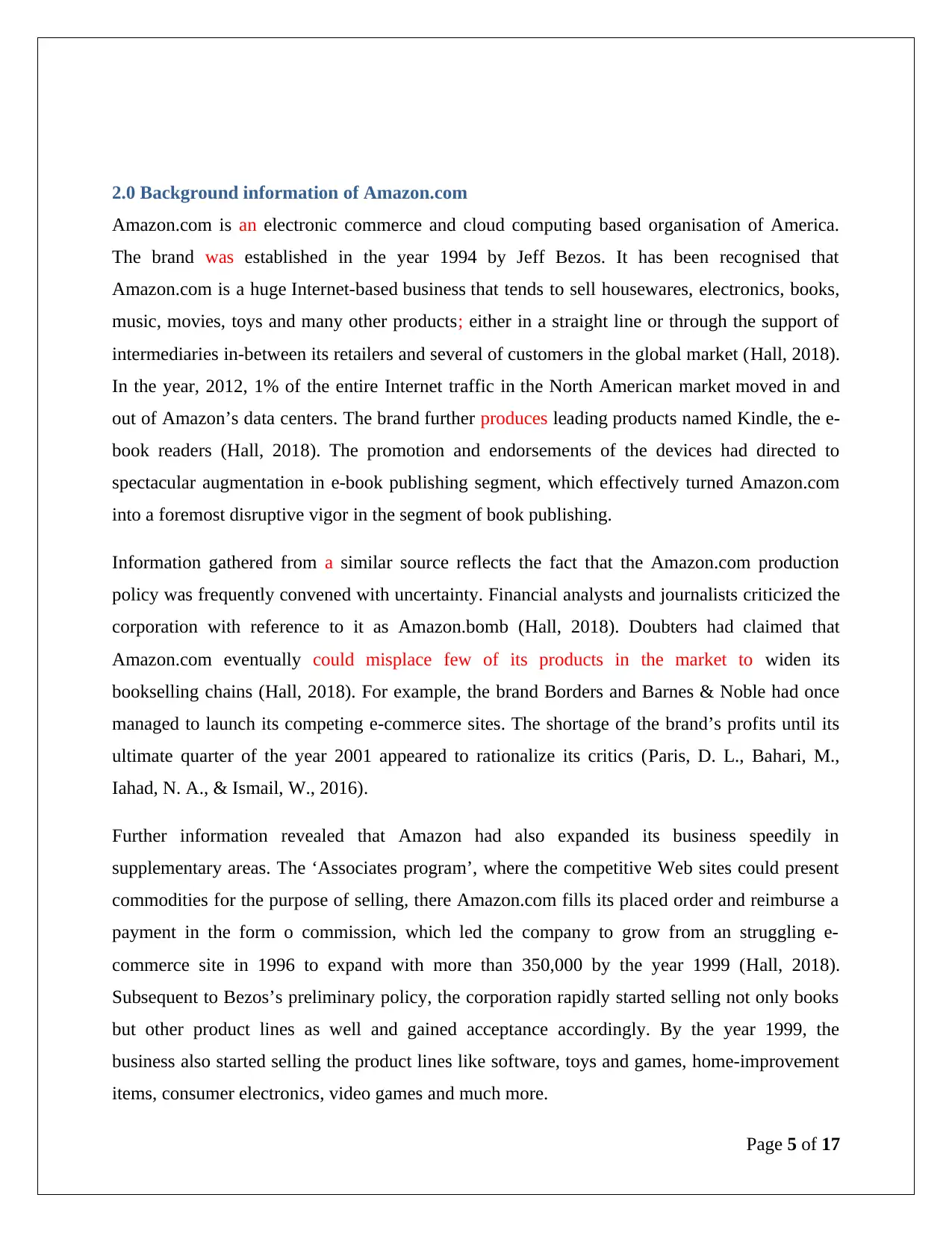
2.0 Background information of Amazon.com
Amazon.com is an electronic commerce and cloud computing based organisation of America.
The brand was established in the year 1994 by Jeff Bezos. It has been recognised that
Amazon.com is a huge Internet-based business that tends to sell housewares, electronics, books,
music, movies, toys and many other products; either in a straight line or through the support of
intermediaries in-between its retailers and several of customers in the global market (Hall, 2018).
In the year, 2012, 1% of the entire Internet traffic in the North American market moved in and
out of Amazon’s data centers. The brand further produces leading products named Kindle, the e-
book readers (Hall, 2018). The promotion and endorsements of the devices had directed to
spectacular augmentation in e-book publishing segment, which effectively turned Amazon.com
into a foremost disruptive vigor in the segment of book publishing.
Information gathered from a similar source reflects the fact that the Amazon.com production
policy was frequently convened with uncertainty. Financial analysts and journalists criticized the
corporation with reference to it as Amazon.bomb (Hall, 2018). Doubters had claimed that
Amazon.com eventually could misplace few of its products in the market to widen its
bookselling chains (Hall, 2018). For example, the brand Borders and Barnes & Noble had once
managed to launch its competing e-commerce sites. The shortage of the brand’s profits until its
ultimate quarter of the year 2001 appeared to rationalize its critics (Paris, D. L., Bahari, M.,
Iahad, N. A., & Ismail, W., 2016).
Further information revealed that Amazon had also expanded its business speedily in
supplementary areas. The ‘Associates program’, where the competitive Web sites could present
commodities for the purpose of selling, there Amazon.com fills its placed order and reimburse a
payment in the form o commission, which led the company to grow from an struggling e-
commerce site in 1996 to expand with more than 350,000 by the year 1999 (Hall, 2018).
Subsequent to Bezos’s preliminary policy, the corporation rapidly started selling not only books
but other product lines as well and gained acceptance accordingly. By the year 1999, the
business also started selling the product lines like software, toys and games, home-improvement
items, consumer electronics, video games and much more.
Page 5 of 17
Amazon.com is an electronic commerce and cloud computing based organisation of America.
The brand was established in the year 1994 by Jeff Bezos. It has been recognised that
Amazon.com is a huge Internet-based business that tends to sell housewares, electronics, books,
music, movies, toys and many other products; either in a straight line or through the support of
intermediaries in-between its retailers and several of customers in the global market (Hall, 2018).
In the year, 2012, 1% of the entire Internet traffic in the North American market moved in and
out of Amazon’s data centers. The brand further produces leading products named Kindle, the e-
book readers (Hall, 2018). The promotion and endorsements of the devices had directed to
spectacular augmentation in e-book publishing segment, which effectively turned Amazon.com
into a foremost disruptive vigor in the segment of book publishing.
Information gathered from a similar source reflects the fact that the Amazon.com production
policy was frequently convened with uncertainty. Financial analysts and journalists criticized the
corporation with reference to it as Amazon.bomb (Hall, 2018). Doubters had claimed that
Amazon.com eventually could misplace few of its products in the market to widen its
bookselling chains (Hall, 2018). For example, the brand Borders and Barnes & Noble had once
managed to launch its competing e-commerce sites. The shortage of the brand’s profits until its
ultimate quarter of the year 2001 appeared to rationalize its critics (Paris, D. L., Bahari, M.,
Iahad, N. A., & Ismail, W., 2016).
Further information revealed that Amazon had also expanded its business speedily in
supplementary areas. The ‘Associates program’, where the competitive Web sites could present
commodities for the purpose of selling, there Amazon.com fills its placed order and reimburse a
payment in the form o commission, which led the company to grow from an struggling e-
commerce site in 1996 to expand with more than 350,000 by the year 1999 (Hall, 2018).
Subsequent to Bezos’s preliminary policy, the corporation rapidly started selling not only books
but other product lines as well and gained acceptance accordingly. By the year 1999, the
business also started selling the product lines like software, toys and games, home-improvement
items, consumer electronics, video games and much more.
Page 5 of 17
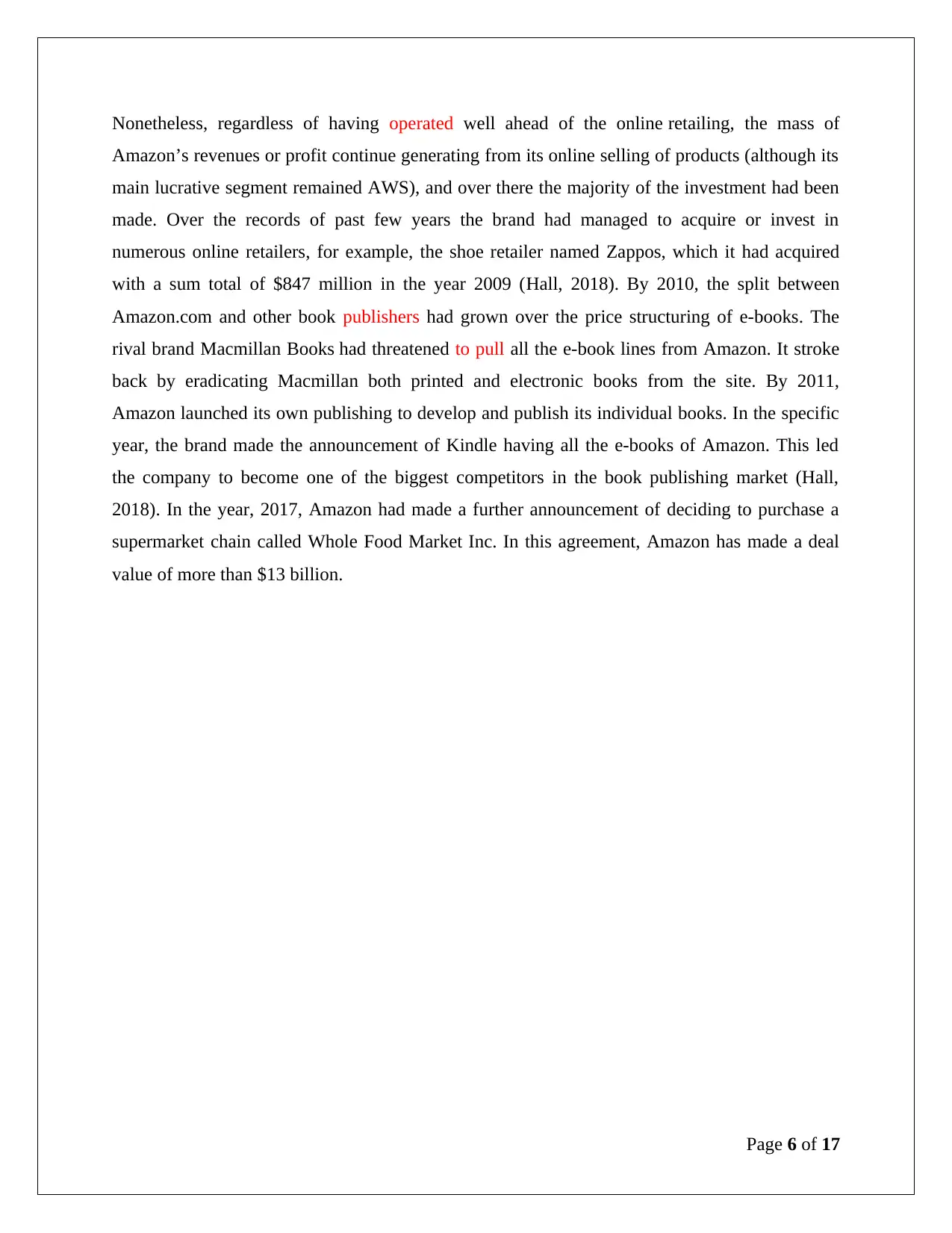
Nonetheless, regardless of having operated well ahead of the online retailing, the mass of
Amazon’s revenues or profit continue generating from its online selling of products (although its
main lucrative segment remained AWS), and over there the majority of the investment had been
made. Over the records of past few years the brand had managed to acquire or invest in
numerous online retailers, for example, the shoe retailer named Zappos, which it had acquired
with a sum total of $847 million in the year 2009 (Hall, 2018). By 2010, the split between
Amazon.com and other book publishers had grown over the price structuring of e-books. The
rival brand Macmillan Books had threatened to pull all the e-book lines from Amazon. It stroke
back by eradicating Macmillan both printed and electronic books from the site. By 2011,
Amazon launched its own publishing to develop and publish its individual books. In the specific
year, the brand made the announcement of Kindle having all the e-books of Amazon. This led
the company to become one of the biggest competitors in the book publishing market (Hall,
2018). In the year, 2017, Amazon had made a further announcement of deciding to purchase a
supermarket chain called Whole Food Market Inc. In this agreement, Amazon has made a deal
value of more than $13 billion.
Page 6 of 17
Amazon’s revenues or profit continue generating from its online selling of products (although its
main lucrative segment remained AWS), and over there the majority of the investment had been
made. Over the records of past few years the brand had managed to acquire or invest in
numerous online retailers, for example, the shoe retailer named Zappos, which it had acquired
with a sum total of $847 million in the year 2009 (Hall, 2018). By 2010, the split between
Amazon.com and other book publishers had grown over the price structuring of e-books. The
rival brand Macmillan Books had threatened to pull all the e-book lines from Amazon. It stroke
back by eradicating Macmillan both printed and electronic books from the site. By 2011,
Amazon launched its own publishing to develop and publish its individual books. In the specific
year, the brand made the announcement of Kindle having all the e-books of Amazon. This led
the company to become one of the biggest competitors in the book publishing market (Hall,
2018). In the year, 2017, Amazon had made a further announcement of deciding to purchase a
supermarket chain called Whole Food Market Inc. In this agreement, Amazon has made a deal
value of more than $13 billion.
Page 6 of 17
⊘ This is a preview!⊘
Do you want full access?
Subscribe today to unlock all pages.

Trusted by 1+ million students worldwide
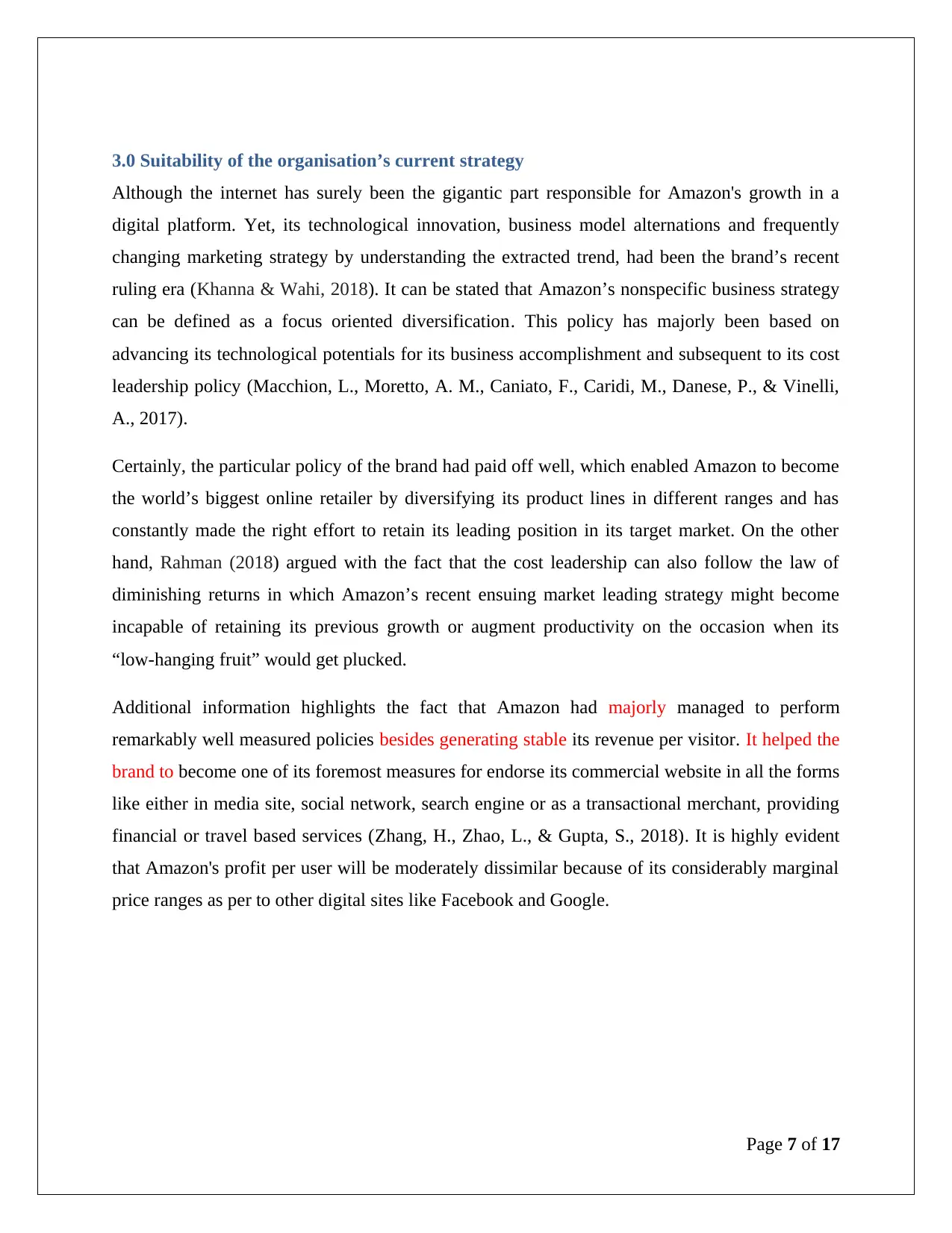
3.0 Suitability of the organisation’s current strategy
Although the internet has surely been the gigantic part responsible for Amazon's growth in a
digital platform. Yet, its technological innovation, business model alternations and frequently
changing marketing strategy by understanding the extracted trend, had been the brand’s recent
ruling era (Khanna & Wahi, 2018). It can be stated that Amazon’s nonspecific business strategy
can be defined as a focus oriented diversification. This policy has majorly been based on
advancing its technological potentials for its business accomplishment and subsequent to its cost
leadership policy (Macchion, L., Moretto, A. M., Caniato, F., Caridi, M., Danese, P., & Vinelli,
A., 2017).
Certainly, the particular policy of the brand had paid off well, which enabled Amazon to become
the world’s biggest online retailer by diversifying its product lines in different ranges and has
constantly made the right effort to retain its leading position in its target market. On the other
hand, Rahman (2018) argued with the fact that the cost leadership can also follow the law of
diminishing returns in which Amazon’s recent ensuing market leading strategy might become
incapable of retaining its previous growth or augment productivity on the occasion when its
“low-hanging fruit” would get plucked.
Additional information highlights the fact that Amazon had majorly managed to perform
remarkably well measured policies besides generating stable its revenue per visitor. It helped the
brand to become one of its foremost measures for endorse its commercial website in all the forms
like either in media site, social network, search engine or as a transactional merchant, providing
financial or travel based services (Zhang, H., Zhao, L., & Gupta, S., 2018). It is highly evident
that Amazon's profit per user will be moderately dissimilar because of its considerably marginal
price ranges as per to other digital sites like Facebook and Google.
Page 7 of 17
Although the internet has surely been the gigantic part responsible for Amazon's growth in a
digital platform. Yet, its technological innovation, business model alternations and frequently
changing marketing strategy by understanding the extracted trend, had been the brand’s recent
ruling era (Khanna & Wahi, 2018). It can be stated that Amazon’s nonspecific business strategy
can be defined as a focus oriented diversification. This policy has majorly been based on
advancing its technological potentials for its business accomplishment and subsequent to its cost
leadership policy (Macchion, L., Moretto, A. M., Caniato, F., Caridi, M., Danese, P., & Vinelli,
A., 2017).
Certainly, the particular policy of the brand had paid off well, which enabled Amazon to become
the world’s biggest online retailer by diversifying its product lines in different ranges and has
constantly made the right effort to retain its leading position in its target market. On the other
hand, Rahman (2018) argued with the fact that the cost leadership can also follow the law of
diminishing returns in which Amazon’s recent ensuing market leading strategy might become
incapable of retaining its previous growth or augment productivity on the occasion when its
“low-hanging fruit” would get plucked.
Additional information highlights the fact that Amazon had majorly managed to perform
remarkably well measured policies besides generating stable its revenue per visitor. It helped the
brand to become one of its foremost measures for endorse its commercial website in all the forms
like either in media site, social network, search engine or as a transactional merchant, providing
financial or travel based services (Zhang, H., Zhao, L., & Gupta, S., 2018). It is highly evident
that Amazon's profit per user will be moderately dissimilar because of its considerably marginal
price ranges as per to other digital sites like Facebook and Google.
Page 7 of 17
Paraphrase This Document
Need a fresh take? Get an instant paraphrase of this document with our AI Paraphraser
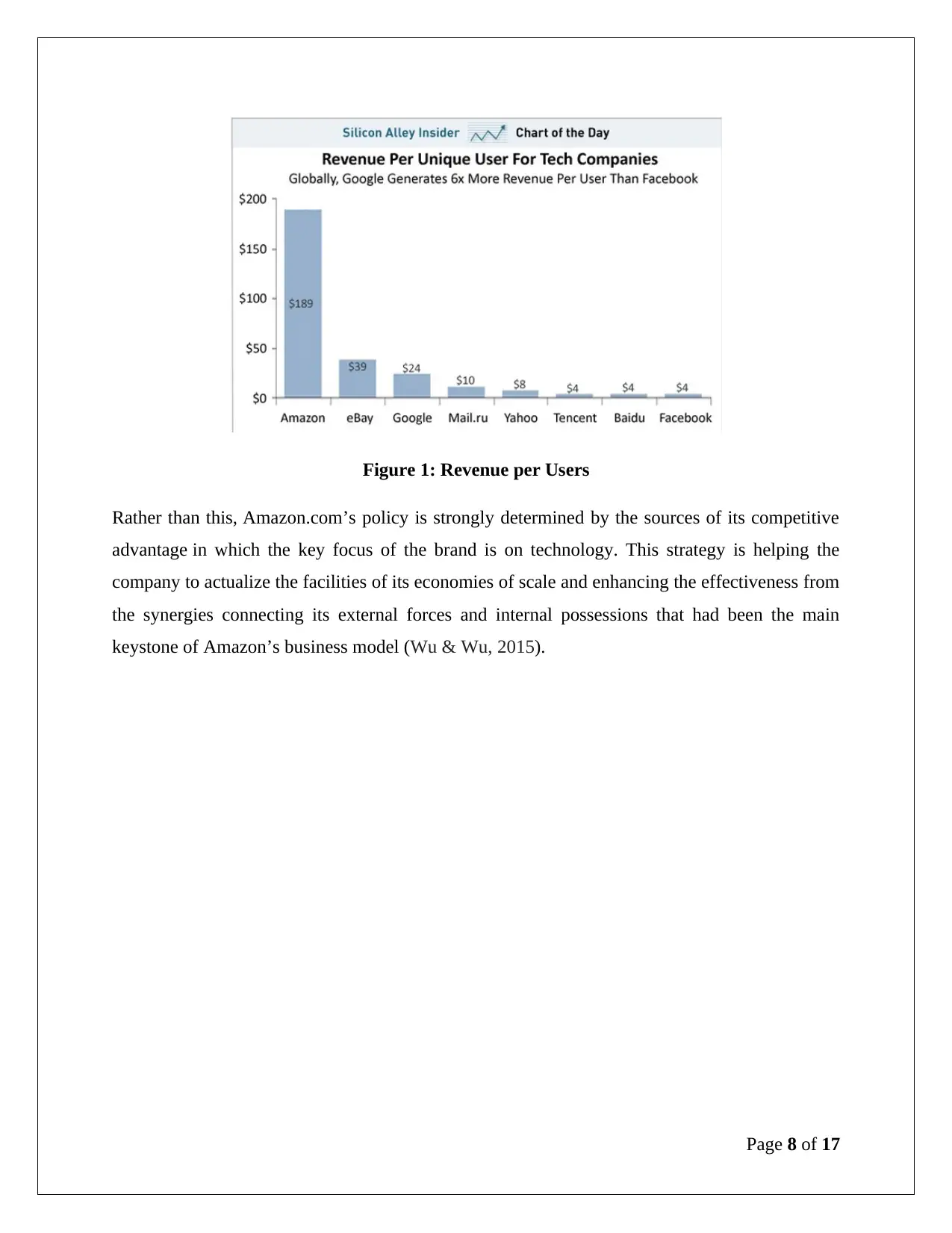
Figure 1: Revenue per Users
Rather than this, Amazon.com’s policy is strongly determined by the sources of its competitive
advantage in which the key focus of the brand is on technology. This strategy is helping the
company to actualize the facilities of its economies of scale and enhancing the effectiveness from
the synergies connecting its external forces and internal possessions that had been the main
keystone of Amazon’s business model (Wu & Wu, 2015).
Page 8 of 17
Rather than this, Amazon.com’s policy is strongly determined by the sources of its competitive
advantage in which the key focus of the brand is on technology. This strategy is helping the
company to actualize the facilities of its economies of scale and enhancing the effectiveness from
the synergies connecting its external forces and internal possessions that had been the main
keystone of Amazon’s business model (Wu & Wu, 2015).
Page 8 of 17
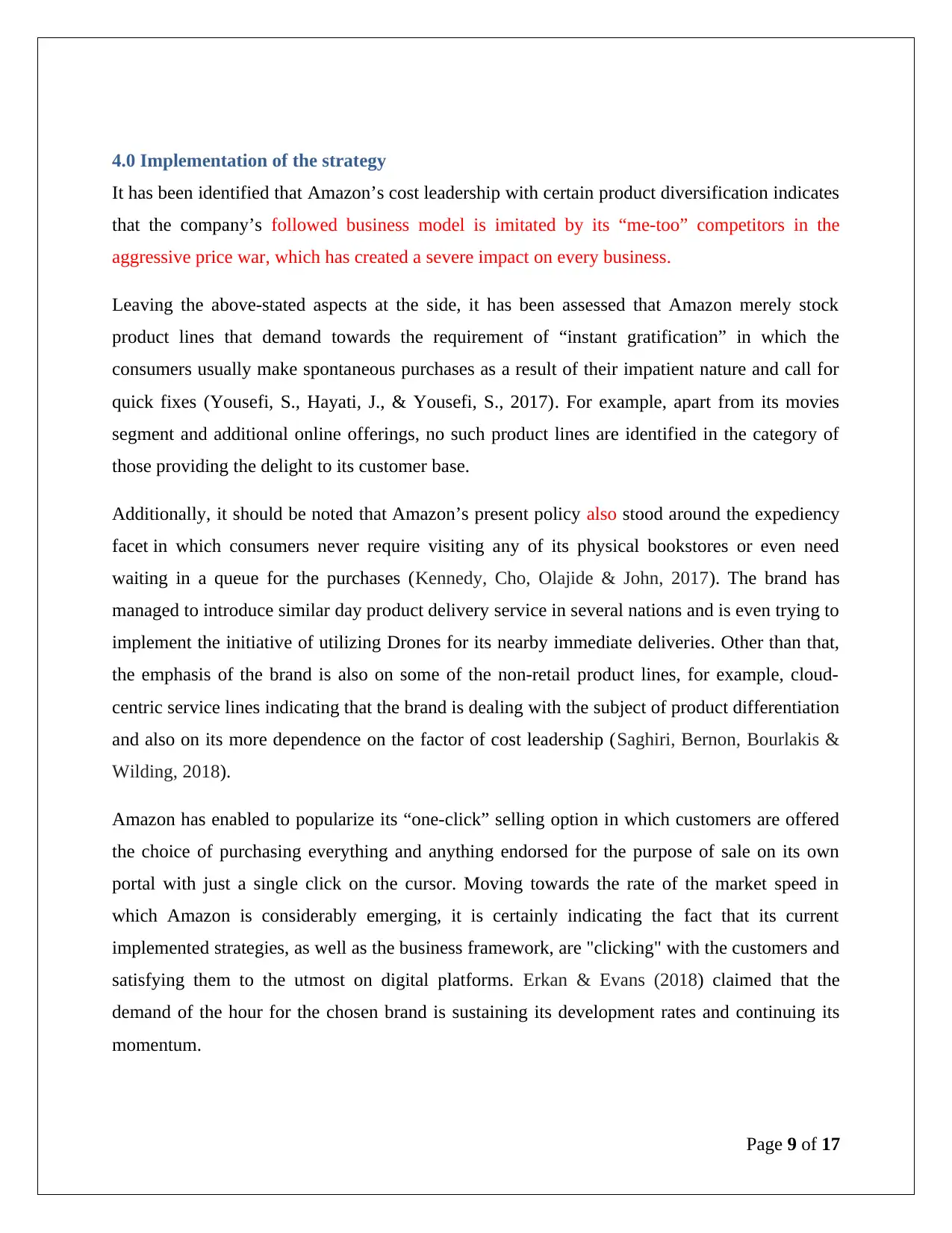
4.0 Implementation of the strategy
It has been identified that Amazon’s cost leadership with certain product diversification indicates
that the company’s followed business model is imitated by its “me-too” competitors in the
aggressive price war, which has created a severe impact on every business.
Leaving the above-stated aspects at the side, it has been assessed that Amazon merely stock
product lines that demand towards the requirement of “instant gratification” in which the
consumers usually make spontaneous purchases as a result of their impatient nature and call for
quick fixes (Yousefi, S., Hayati, J., & Yousefi, S., 2017). For example, apart from its movies
segment and additional online offerings, no such product lines are identified in the category of
those providing the delight to its customer base.
Additionally, it should be noted that Amazon’s present policy also stood around the expediency
facet in which consumers never require visiting any of its physical bookstores or even need
waiting in a queue for the purchases (Kennedy, Cho, Olajide & John, 2017). The brand has
managed to introduce similar day product delivery service in several nations and is even trying to
implement the initiative of utilizing Drones for its nearby immediate deliveries. Other than that,
the emphasis of the brand is also on some of the non-retail product lines, for example, cloud-
centric service lines indicating that the brand is dealing with the subject of product differentiation
and also on its more dependence on the factor of cost leadership (Saghiri, Bernon, Bourlakis &
Wilding, 2018).
Amazon has enabled to popularize its “one-click” selling option in which customers are offered
the choice of purchasing everything and anything endorsed for the purpose of sale on its own
portal with just a single click on the cursor. Moving towards the rate of the market speed in
which Amazon is considerably emerging, it is certainly indicating the fact that its current
implemented strategies, as well as the business framework, are "clicking" with the customers and
satisfying them to the utmost on digital platforms. Erkan & Evans (2018) claimed that the
demand of the hour for the chosen brand is sustaining its development rates and continuing its
momentum.
Page 9 of 17
It has been identified that Amazon’s cost leadership with certain product diversification indicates
that the company’s followed business model is imitated by its “me-too” competitors in the
aggressive price war, which has created a severe impact on every business.
Leaving the above-stated aspects at the side, it has been assessed that Amazon merely stock
product lines that demand towards the requirement of “instant gratification” in which the
consumers usually make spontaneous purchases as a result of their impatient nature and call for
quick fixes (Yousefi, S., Hayati, J., & Yousefi, S., 2017). For example, apart from its movies
segment and additional online offerings, no such product lines are identified in the category of
those providing the delight to its customer base.
Additionally, it should be noted that Amazon’s present policy also stood around the expediency
facet in which consumers never require visiting any of its physical bookstores or even need
waiting in a queue for the purchases (Kennedy, Cho, Olajide & John, 2017). The brand has
managed to introduce similar day product delivery service in several nations and is even trying to
implement the initiative of utilizing Drones for its nearby immediate deliveries. Other than that,
the emphasis of the brand is also on some of the non-retail product lines, for example, cloud-
centric service lines indicating that the brand is dealing with the subject of product differentiation
and also on its more dependence on the factor of cost leadership (Saghiri, Bernon, Bourlakis &
Wilding, 2018).
Amazon has enabled to popularize its “one-click” selling option in which customers are offered
the choice of purchasing everything and anything endorsed for the purpose of sale on its own
portal with just a single click on the cursor. Moving towards the rate of the market speed in
which Amazon is considerably emerging, it is certainly indicating the fact that its current
implemented strategies, as well as the business framework, are "clicking" with the customers and
satisfying them to the utmost on digital platforms. Erkan & Evans (2018) claimed that the
demand of the hour for the chosen brand is sustaining its development rates and continuing its
momentum.
Page 9 of 17
⊘ This is a preview!⊘
Do you want full access?
Subscribe today to unlock all pages.

Trusted by 1+ million students worldwide

Page 10 of 17
Paraphrase This Document
Need a fresh take? Get an instant paraphrase of this document with our AI Paraphraser
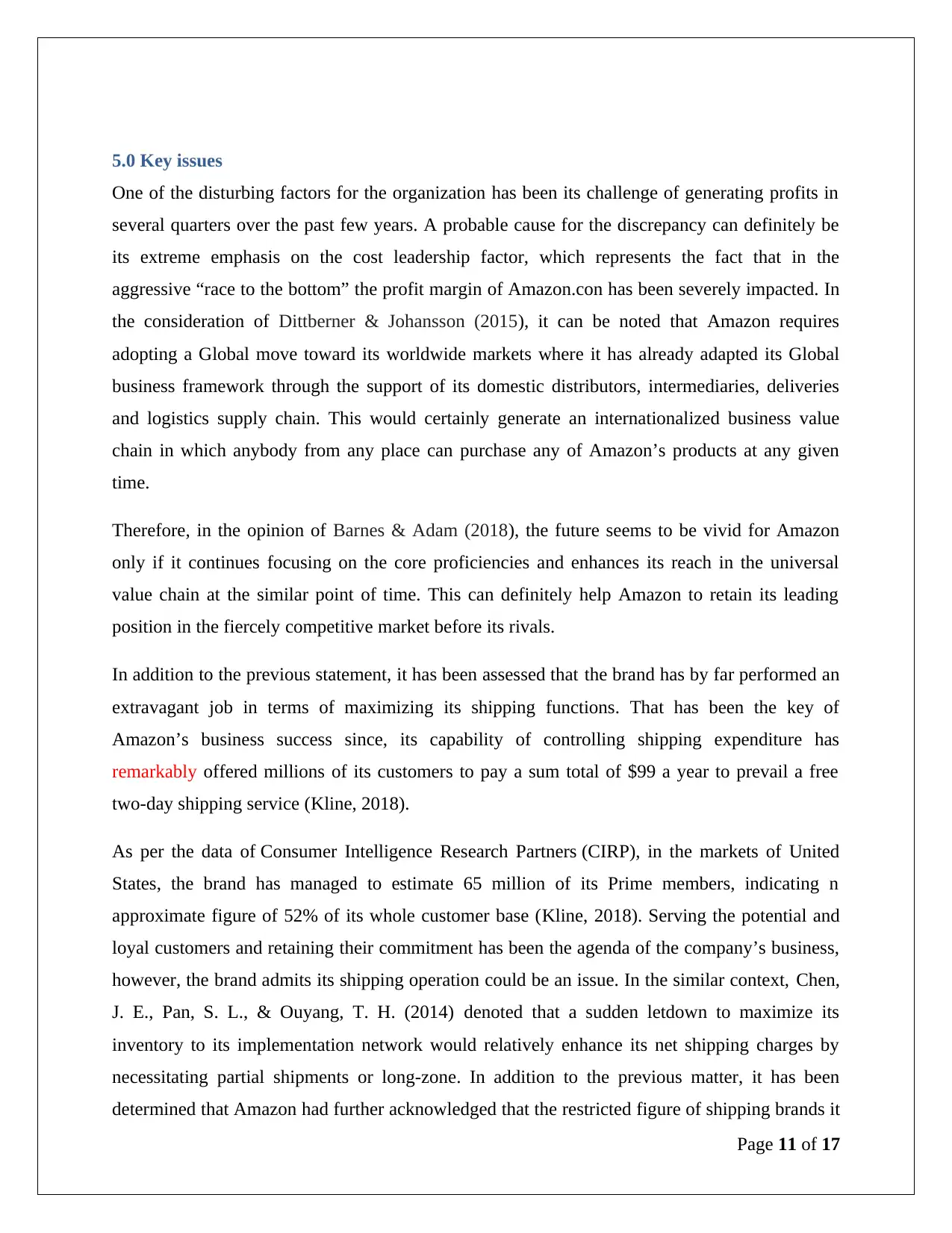
5.0 Key issues
One of the disturbing factors for the organization has been its challenge of generating profits in
several quarters over the past few years. A probable cause for the discrepancy can definitely be
its extreme emphasis on the cost leadership factor, which represents the fact that in the
aggressive “race to the bottom” the profit margin of Amazon.con has been severely impacted. In
the consideration of Dittberner & Johansson (2015), it can be noted that Amazon requires
adopting a Global move toward its worldwide markets where it has already adapted its Global
business framework through the support of its domestic distributors, intermediaries, deliveries
and logistics supply chain. This would certainly generate an internationalized business value
chain in which anybody from any place can purchase any of Amazon’s products at any given
time.
Therefore, in the opinion of Barnes & Adam (2018), the future seems to be vivid for Amazon
only if it continues focusing on the core proficiencies and enhances its reach in the universal
value chain at the similar point of time. This can definitely help Amazon to retain its leading
position in the fiercely competitive market before its rivals.
In addition to the previous statement, it has been assessed that the brand has by far performed an
extravagant job in terms of maximizing its shipping functions. That has been the key of
Amazon’s business success since, its capability of controlling shipping expenditure has
remarkably offered millions of its customers to pay a sum total of $99 a year to prevail a free
two-day shipping service (Kline, 2018).
As per the data of Consumer Intelligence Research Partners (CIRP), in the markets of United
States, the brand has managed to estimate 65 million of its Prime members, indicating n
approximate figure of 52% of its whole customer base (Kline, 2018). Serving the potential and
loyal customers and retaining their commitment has been the agenda of the company’s business,
however, the brand admits its shipping operation could be an issue. In the similar context, Chen,
J. E., Pan, S. L., & Ouyang, T. H. (2014) denoted that a sudden letdown to maximize its
inventory to its implementation network would relatively enhance its net shipping charges by
necessitating partial shipments or long-zone. In addition to the previous matter, it has been
determined that Amazon had further acknowledged that the restricted figure of shipping brands it
Page 11 of 17
One of the disturbing factors for the organization has been its challenge of generating profits in
several quarters over the past few years. A probable cause for the discrepancy can definitely be
its extreme emphasis on the cost leadership factor, which represents the fact that in the
aggressive “race to the bottom” the profit margin of Amazon.con has been severely impacted. In
the consideration of Dittberner & Johansson (2015), it can be noted that Amazon requires
adopting a Global move toward its worldwide markets where it has already adapted its Global
business framework through the support of its domestic distributors, intermediaries, deliveries
and logistics supply chain. This would certainly generate an internationalized business value
chain in which anybody from any place can purchase any of Amazon’s products at any given
time.
Therefore, in the opinion of Barnes & Adam (2018), the future seems to be vivid for Amazon
only if it continues focusing on the core proficiencies and enhances its reach in the universal
value chain at the similar point of time. This can definitely help Amazon to retain its leading
position in the fiercely competitive market before its rivals.
In addition to the previous statement, it has been assessed that the brand has by far performed an
extravagant job in terms of maximizing its shipping functions. That has been the key of
Amazon’s business success since, its capability of controlling shipping expenditure has
remarkably offered millions of its customers to pay a sum total of $99 a year to prevail a free
two-day shipping service (Kline, 2018).
As per the data of Consumer Intelligence Research Partners (CIRP), in the markets of United
States, the brand has managed to estimate 65 million of its Prime members, indicating n
approximate figure of 52% of its whole customer base (Kline, 2018). Serving the potential and
loyal customers and retaining their commitment has been the agenda of the company’s business,
however, the brand admits its shipping operation could be an issue. In the similar context, Chen,
J. E., Pan, S. L., & Ouyang, T. H. (2014) denoted that a sudden letdown to maximize its
inventory to its implementation network would relatively enhance its net shipping charges by
necessitating partial shipments or long-zone. In addition to the previous matter, it has been
determined that Amazon had further acknowledged that the restricted figure of shipping brands it
Page 11 of 17

performs with might create a boost in its shipping charges, which would definitely create a
severe impact to maintain its bottom line ratio.
Page 12 of 17
severe impact to maintain its bottom line ratio.
Page 12 of 17
⊘ This is a preview!⊘
Do you want full access?
Subscribe today to unlock all pages.

Trusted by 1+ million students worldwide
1 out of 17
Related Documents
Your All-in-One AI-Powered Toolkit for Academic Success.
+13062052269
info@desklib.com
Available 24*7 on WhatsApp / Email
![[object Object]](/_next/static/media/star-bottom.7253800d.svg)
Unlock your academic potential
Copyright © 2020–2025 A2Z Services. All Rights Reserved. Developed and managed by ZUCOL.





